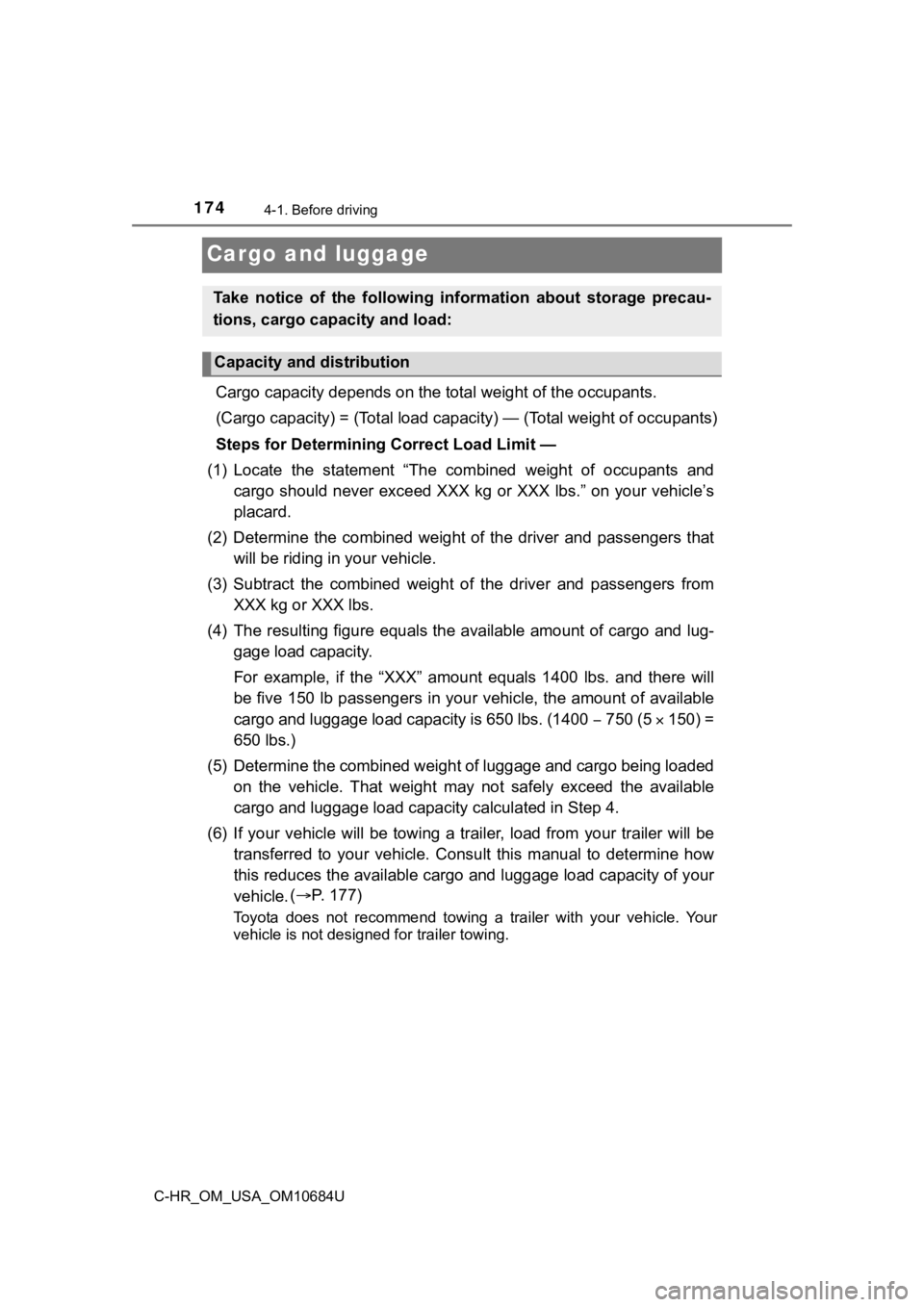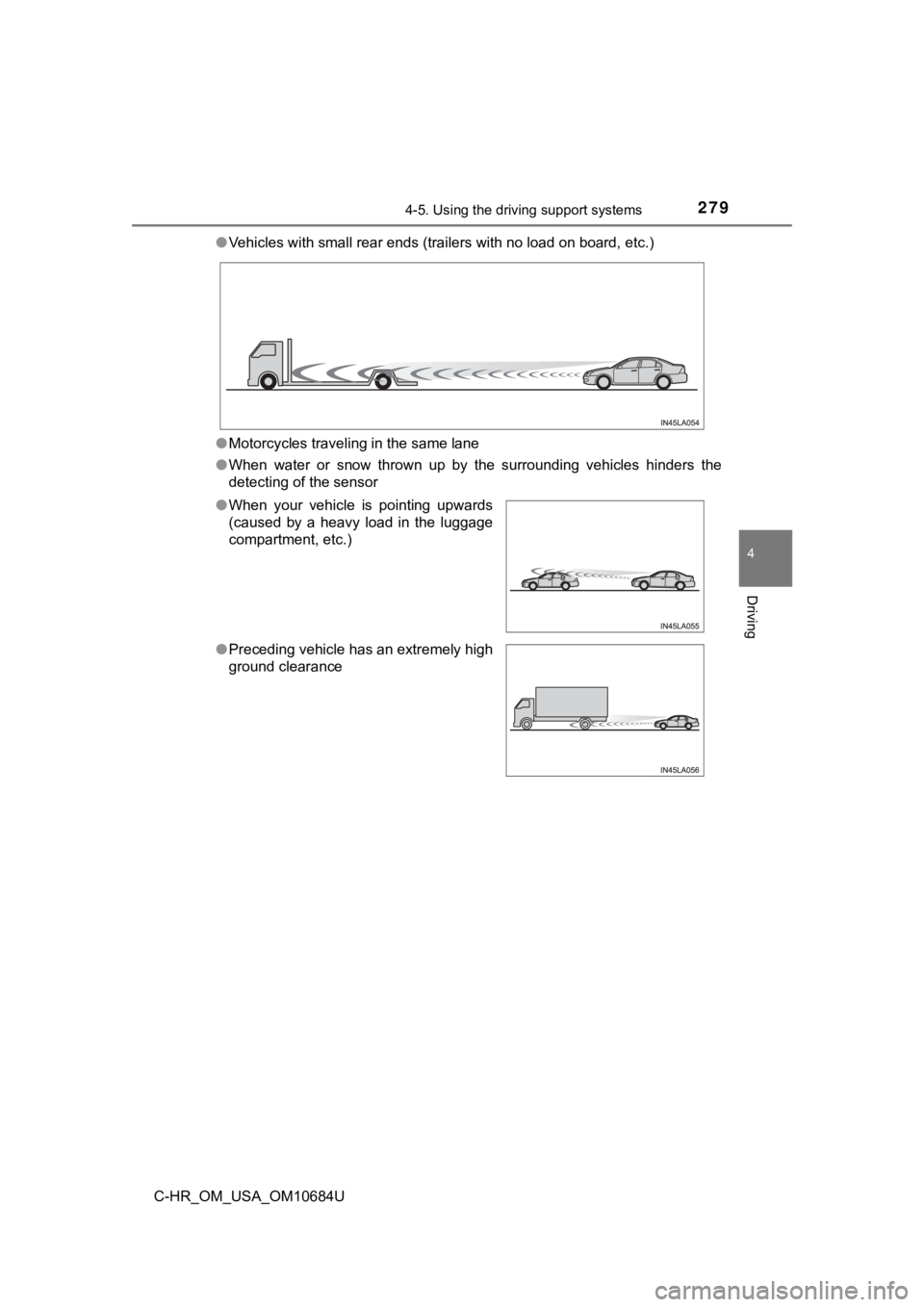2021 TOYOTA C-HR trailer
[x] Cancel search: trailerPage 3 of 548

3
1
8 7 5 4
3
2
9
C-HR_OM_USA_OM10684U
6
4-1. Before drivingDriving the vehicle ............. 164
Cargo and luggage............ 174
Vehicle load limits ............. 177
Trailer towing..................... 178
Dinghy towing.................... 179
4-2. Driving procedures Engine (ignition) switch (vehicles without a
smart key system) ........... 180
Engine (ignition) switch (vehicles with a
smart key system) ........... 183
Continuously variable transmission .................... 190
Turn signal lever................ 195
Parking brake .................... 196
Brake Hold ........................ 201
4-3. Operating the lights and wipers
Headlight switch ................ 204
Automatic High Beam ....... 209
Fog light switch ................. 214
Windshield wipers and washer ............................ 215
Rear window wiper and washer ............................ 218 4-4. Refueling
Opening the fuel tank cap................................... 220
4-5. Using the driving support systems
Toyota Safety Sense 2.5 ... 224
PCS (Pre-Collision System)..... 231
LTA (Lane Tracing Assist) ...... 246
RSA (Road Sign Assist) .... 261
Dynamic radar cruise control with
full-speed range............... 266
Driving mode select ........... 281
BSM (Blind Spot Monitor)......... 283
RCTA (Rear Cross Traffic Alert) ..................... 292
Driving assist systems ....... 300
4-6. Driving tips Winter driving tips .............. 306
4Driving
Page 163 of 548

163
4Driving
C-HR_OM_USA_OM10684U4-1. Before driving
Driving the vehicle ............. 164
Cargo and luggage ........... 174
Vehicle load limits ............. 177
Trailer towing..................... 178
Dinghy towing ................... 179
4-2. Driving procedures Engine (ignition) switch (vehicles without a
smart key system) ........... 180
Engine (ignition) switch (vehicles with a
smart key system) ........... 183
Continuously variable transmission .................... 190
Turn signal lever................ 195
Parking brake .................... 196
Brake Hold ........................ 201
4-3. Operating the lights and wipers
Headlight switch ................ 204
Automatic High Beam ....... 209
Fog light switch ................. 214
Windshield wipers and washer ............................ 215
Rear window wiper and washer ............................ 218 4-4. Refueling
Opening the fuel tank cap ................... 220
4-5. Using the driving support systems
Toyota Safety Sense 2.5... 224
PCS (Pre-Collision System) .... 231
LTA (Lane Tracing Assist) ...... 246
RSA (Road Sign Assist) .... 261
Driving mode select .......... 281
BSM (Blind Spot Monitor) ........ 283
RCTA (Rear Cross Traffic Alert) .................... 292
Driving assist systems ...... 300
4-6. Driving tips Winter driving tips ............. 306
Page 174 of 548

1744-1. Before driving
C-HR_OM_USA_OM10684U
Cargo and luggage
Cargo capacity depends on the total weight of the occupants.
(Cargo capacity) = (Total load capacity) — (Total weight of occ upants)
Toyota does not recommend towing a trailer with your vehicle. Y our
vehicle is not desig ned for trailer towing.
Take notice of the following information about storage precau-
tions, cargo capacity and load:
Capacity and distribution
Steps for Determining Correct Load Limit —
(1) Locate the statement “The c ombined weight of occupants and
cargo should never exceed XXX kg or XXX lbs.” on your vehicle’s
placard.
(2) Determine the combined weight of the driver and passengers t hat
will be riding in your vehicle.
(3) Subtract the combined weight of the driver and passengers fr om
XXX kg or XXX lbs.
(4) The resulting figure equals th e available amount of cargo and lug-
gage load capacity.
For example, if the “XXX” amount equals 1400 lbs. and there wil l
be five 150 lb passengers in your vehicle, the amount of available
cargo and luggage load capacity is 650 lbs. (1400 750 (5 150) =
650 lbs.)
(5) Determine the combined weight of luggage and cargo being loa ded
on the vehicle. That weight may n ot safely exceed the available
cargo and luggage load capacity calculated in Step 4.
(6) If your vehicle will be towing a trailer, load from your tra iler will be
transferred to your vehicle. Consult this manual to determine h ow
this reduces the available cargo and luggage load capacity of y our
vehicle. (
P. 177)
Page 177 of 548

1774-1. Before driving
4
Driving
C-HR_OM_USA_OM10684U
Vehicle load limits
◆Total load capacity (vehicle capacity weight): (P. 4 7 6 )
Total load capacity means the co mbined weight of occupants, cargo
and luggage.
◆Seating capacity: ( P. 476)
Seating capacity means the max imum number of occupants whose
estimated average weight is 1 50 lb. (68 kg) per person.
◆Towing capacity
Toyota does not recommend towing a trailer with your vehicle.
◆Cargo capacity
Cargo capacity may increase or decrease depending on the weight
and the number of occupants.
■Total load capacity and seating capacity
These details are also described on the tire and loading inform ation label.
( P. 386)
Vehicle load limits include total load capacity, seating capaci ty,
towing capacity and cargo capacity.
WARNING
■Overloading the vehicle
Do not overload the vehicle.
It may not only cause damage to the tires, but also degrade steering
and braking ability, res ulting in an accident.
Page 178 of 548

1784-1. Before driving
C-HR_OM_USA_OM10684U
Trailer towing
Toyota does not recommend towing a trailer with your vehicle.
Toyota also does not recommend the installation of a tow hitch
or the use of a tow hitch carrier for a wheelchair, scooter, bi cy-
cle, etc. Your vehicle is not des igned for trailer towing or for the
use of tow hitch mounted carriers.
Page 212 of 548

2124-3. Operating the lights and wipers
C-HR_OM_USA_OM10684U●
The high beam may be turned on or off when the driver does not expect it.
● Bicycles or similar objects may not be detected.
● In the situations shown below, the system may not be able to accurately
detect surrounding brightness levels. This may cause the low be ams to
remain on or the high beams to cause problems for pedestrians, vehicles
ahead or other parties. In these cases, manually switch between the high
and low beams.
• In bad weather (rain, snow, fog, sandstorms, etc.)
• The windshield is obscured by fog, mist, ice, dirt, etc.
• The windshield is cracked or damaged.
• The front camera is deformed or dirty.
• The front camera temperature is extremely high.
• Surrounding brightness levels are equal to those of headlights , tail lights
or fog lights.
• Vehicles ahead have headlights that are either switched off, d irty, are
changing color, or are not aimed properly.
• When driving through an area of intermittently changing brightness and darkness.
• When frequently and repeatedly driving ascending/descending roads, or
roads with rough, bumpy or uneven surfaces (such as stone-paved
roads, gravel tracks, etc.).
• When frequently and repeatedly taking curves or driving on a w inding
road.
• There is a highly reflective object ahead of the vehicle, such as a sign or a mirror.
• The back of a vehicle ahead is highly reflective, such as a co ntainer on a
truck.
• The vehicle’s headlights are damaged or dirty.
• The vehicle is listing or tilting, due to a flat tire, a trailer being towed etc.
• The high beam and low beam are repeatedly being switched betwe en in
an abnormal manner.
• The driver believes that the high beam may be causing problems or dis-
tress to other drivers or pedestrians nearby.
Page 243 of 548

2434-5. Using the driving support systems
4
Driving
C-HR_OM_USA_OM10684U• When a detectable object is under a structure
• When part of a detectable object is hidden by an object, such
as large
baggage, an umbrella, or guardrail
• When there are many things which can reflect the radio waves of the
radar in the vicinity (tunnels, truss bridges, gravel roads, sn ow covered
road that have tracks, etc.)
• When there is an effect on the radio waves to the radar that i s installed on
another vehicle
• When multiple detectable objects are close together
• If the sun or other light is shining directly on a detectable object
• When a detectable object is a shade of white and looks extremely bright
• When a detectable object appears to be nearly the same color o r bright-
ness as its surroundings
• If a detectable object cuts or suddenly emerges in front of your vehicle
• When the front of your vehicle is hit by water, snow, dust, et c.
• When a very bright light ahead, such as the sun or the headlig hts of
oncoming traffic, shines directly into the front camera
• When approaching the side or front of a vehicle ahead
• If a vehicle ahead is a motorcycle
• If a vehicle ahead is narrow, such as a personal mobility vehi cle
• If a preceding vehicle has a small rear end, such as an unload ed truck
• If a vehicle ahead is carrying a load which protrudes past its rear bumper
• If a vehicle ahead is irregularly shaped, such as a tractor or side car
• If a vehicle ahead is a child sized bicycle, a bicycle that is carrying a large
load, a bicycle ridden by more than one person, or a uniquely shaped
bicycle (bicycle with a child seat, tandem bicycle, etc.)
• If a pedestrian/or the riding height of a bicyclist ahead is s horter than
approximately 3.2 ft. (1 m) or taller than approximately 6.5 ft. (2 m)
• If a preceding vehicle has a low rear
end, such as a low bed trailer
• If a vehicle ahead has extremely high ground clearance
Page 279 of 548

2794-5. Using the driving support systems
4
Driving
C-HR_OM_USA_OM10684U●
Vehicles with small rear ends (trailers with no load on board, etc.)
● Motorcycles traveling in the same lane
● When water or snow thrown up by the surrounding vehicles hinders the
detecting of the sensor
●When your vehicle is pointing upwards
(caused by a heavy load in the luggage
compartment, etc.)
● Preceding vehicle has an extremely high
ground clearance